1961 nickels are interesting coins to collect. They have a great history as they are part of a series that has been minted since 1866. Collectors and investors alike are often interested in the value of these coins, as they can range from a few cents to thousands of dollars.
Circulated coins are usually just worth their face value but uncirculated or error coins can be worth much more. Here we’ll look at the different varieties, and their value while also providing you with some history of the coin. Let’s get started!
1961 Nickel Coin Details
- Type: Jefferson Five Cents
- Quantity Produced: 302,982,860
- Designer: Felix Schlag
- Edge: Plain
- Shape: Round
- Coin Diameter: 21.21 mm
- Coin Thickness: 1.95 mm
- Coin Weight: 5 grams
- Year of Minting: 1961
- Mint Mark: None/D
- Place of Minting: Philadelphia (73,640,100), Denver (229,342,760)
- Face Value: $0.05
- $ price: $0.05 to $10,800
The 1961 nickel coin, also known as the Jefferson Nickel, is a unique piece of American currency. This coin was struck at two different mints: Philadelphia, and Denver, each of which produced coins with slightly different characteristics. Let’s take a closer look at the specifications of this coin and what makes it unique.
The 1961 nickel is composed of 75% copper and 25% nickel. This composition has remained unchanged since the nickel was first introduced in 1866. The use of nickel in the coin’s composition gave it its name and provided a durable, corrosion-resistant metal that was ideal for coinage.
The edge of the 1961 nickel is smooth, with no ridges or inscriptions. This is a characteristic shared by all Jefferson Nickels, which have had a smooth edge since their introduction in 1938. The 1961 nickel has a diameter of 21.21 millimeters and a weight of 5 grams.
The obverse (front face) of the 1961 nickel features a portrait of Thomas Jefferson, the third President of the United States. The portrait was designed by Felix Schlag, a German-born artist who won a national competition to design the new nickel in 1938.
The design features Jefferson facing to the left, with the words “IN GOD WE TRUST” in front of his face, with the word “LIBERTY” behind his head, along with the date of 1961
The reverse of the 1961 nickel features an image of Monticello (Jefferson’s Virginia estate), with the word “MONTICELLO” written underneath. The Denver mint mark of ‘D’ can be found to the right of the Monticello image, as you look at the coin.
The words “E PLURIBUS UNUM” (Latin for “Out of many, one) are located above the building, and “FIVE CENTS” is below it. Along the bottom edge are the words “UNITED STATES OF AMERICA”.
The total mintage for the 1961 nickel was relatively high, with a total of 302,982,860 coins produced. The vast majority of these coins were produced at the Denver mint, with nearly a quarter of a billion being made there. Nearly 74 million were struck in Philadelphia.
Also Read: 15 Most Valuable Nickels Worth Money
1961 Nickel Coin Value Chart
| Coin Grade | Good | 60 | 64 | 67 |
| 1961 Nickel | $0.10 | $0.25 | $4 | $1,500 |
| 1961 D Nickel | $0.10 | $0.25 | $4 | $1,500 |
| 1961 Proof Nickel | $0.10 | $10 | $12.50 | $100 |
1961 Nickel Value and Varieties Guides
The only real value of these coins comes for those that are in perfect MS67 condition. These coins can fetch around $1,500 at the auction but the exact value can vary a lot. The highest-selling 1961 nickel at auction was $10,800, but this was freakishly high. In contrast, there was an MS67 coin sold in 2022 for $384.
There is usually a big drop-off for coins rated at MS66, as these usually only sell for $20 to $30. Those at MS65 usually sell for $10. As you can see, unless you have one of the best examples of these coins, they’ll be worth little more than face value.
Let’s now take a look at the different varieties of the 1961 nickel. There are three varieties that we’ll look at. They are the circulated coins in Philadelphia and Denver, along with the proof coins which were also minted in Philadelphia.
1961 Nickel
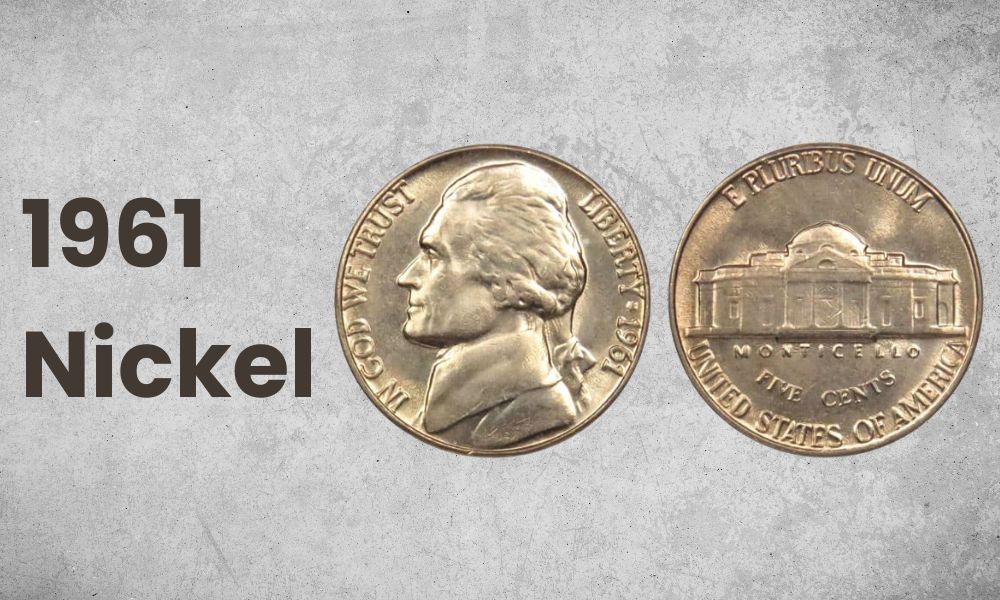
- Type: Jefferson Five Cents
- Edge: Plain
- Mint Mark: None
- Place of Minting: Philadelphia
- Year of Minting: 1961
- Face Value: $0.05
- $ Price: $0.10 to $1,500
- Quantity Produced: 73,640,100
- Designer: Felix Schlag
As with most coins produced in Philadelphia around this time, these coins did not have a mint mark. This contrasts with other facilities around the country such as Denver and San Francisco. Therefore, even though there isn’t a mark, it’s easy to know which coins were minted in the city.
Even though Denver made more coins, the sheer volume of coins minted (73,640,100) means that standard no-mark coins don’t have any particular value. In good condition, you can still only expect them to be at face value.
Even coins in extremely good condition will struggle to fetch much more than face value. As with the Denver coins, you can usually only get above-good value for uncirculated coins. Usually, the only exception to this is nickels that have an error.
1961 D Nickel
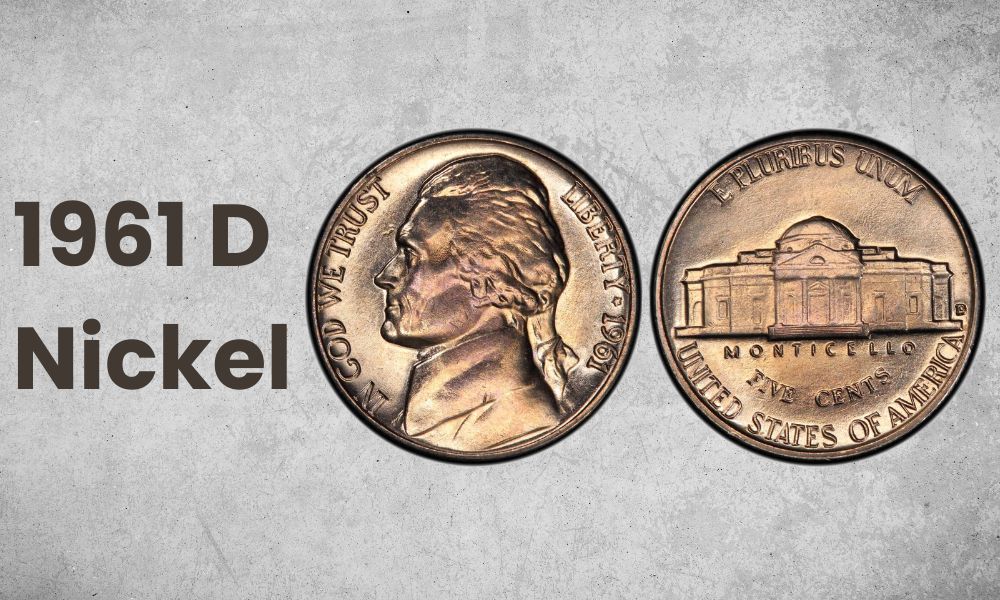
- Type: Jefferson Five Cents
- Edge: Plain
- Mint Mark: D
- Place of Minting: Denver
- Year of Minting: 1961
- Face Value: $0.05
- $ Price: $0.10 to $1,500
- Quantity Produced: 229,342,760
- Designer: Felix Schlag
The largest number of nickels produced in 1961 came from Denver. Here you will see the mint mark of ‘D’ situated to the right of the Monticello. It’s quite easy to spot and easy to distinguish from the coins made in Philadelphia.
As with the no-mark coins, unless there is anything special about them, they’ll be worth no more than face value. These coins weren’t produced in small enough quantities for standard coins in great condition to be worth very much.
1961 Proof Nickel
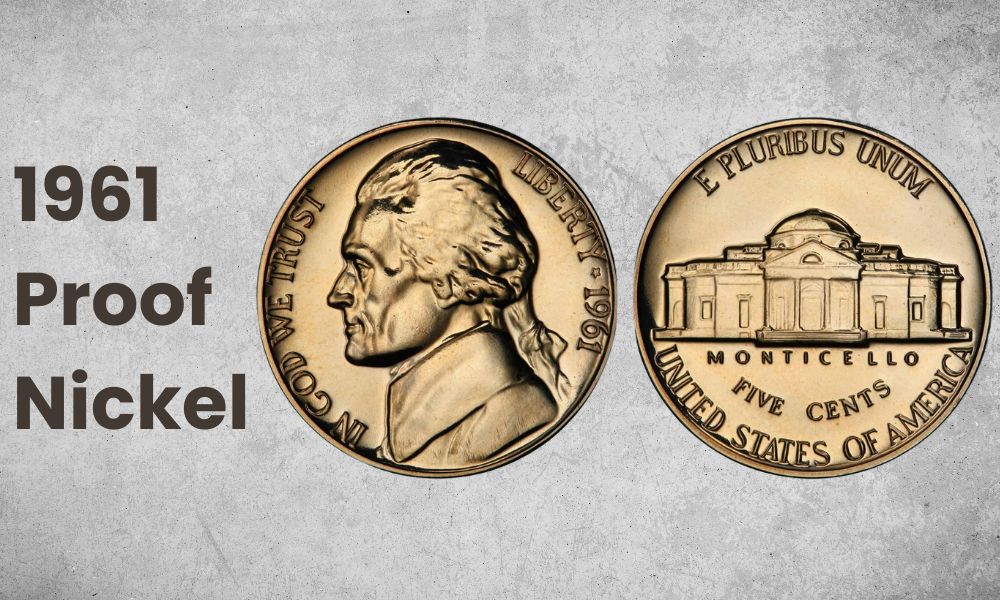
- Type: Jefferson Five Cents
- Edge: Plain
- Mint Mark: None
- Place of Minting: Philadelphia
- Year of Minting: 1961
- Face Value: $0.05
- $ Price: $0.10 to $100
- Quantity Produced: 3,028,144
- Designer: Felix Schlag
There were quite a few proof coins made of the 1961 nickel, which makes them the rarest form of that year’s coinage. These coins are meant to be perfect examples, which means they are often shinier and more detailed than regular coins.
They usually have a value well above face value as they were never meant for circulation. That means a lot of these coins are in perfect condition. However, considering over three million were made, they aren’t too rare.
Also Read: Top 110 Most Valuable Nickels Worth Money
1961 Nickel History
The 1961 nickel is part of the Jefferson nickel series, which began production in 1938. While the 1961 nickel may not be particularly rare, its year of mint does have some historical significance. One such historical event was the Space Race in the year 1961 when the United States was in the midst of the Cold War and the Space Race with the Soviet Union.
This was also the year that astronaut Alan Shepard became the first American to travel to space. The 1961 nickel features a portrait of Thomas Jefferson, who was an avid scientist and inventor. The coin’s design serves as a reminder of America’s technological progress and the role of science in shaping the country’s history.
The 1961 Jefferson nickel features the words “IN GOD WE TRUST” and “LIBERTY,” which represent some of the founding principles of the United States. They are also reflective of the civil rights struggles of the era.
When it comes to the value of the 1961 nickel coin, a number of factors come into play. These factors include the condition of the coin, the mint that produced it, and any varieties that may exist.
Like any coin, the condition of the 1961 nickel can have a big impact on its value. Coins that are in pristine, uncirculated condition are generally more valuable than coins that have been heavily circulated or damaged. When it comes to the 1961 nickel, coins that have a full strike with no weakness in the details tend to be the most valuable.
Proof coins are specially made for collectors and are struck using a higher quality planchet and dies. The 1961-proof nickel was produced at the Philadelphia Mint and features a deep cameo contrast between the frosted devices and mirrored fields. These coins are highly collectible and can be worth several hundred dollars in high grades.
There are also graded coins that can be worth thousands of dollars depending on their condition. Grading services such as PCGS and NGC can certify the condition of coins and assign them a grade. Coins that are assigned a grade of MS-65 or higher are usually worth hundreds or even thousands of dollars.
Also Read: Top 19 Most Valuable Jefferson Nickels Worth Money
1961 Nickel Grading
When it comes to grading the 1961 nickel, the Sheldon Coin Grading Scale is typically used. This scale ranges from 1 (worst) to 70 (perfect). The most common grades are in the range of Very Fine (VF) to Extremely Fine (EF), with coins in these grades showing some wear but still retaining much of their original detail.
Uncirculated 1961 nickel coins are those that have not been used in circulation and are typically graded from Mint State 60 (MS60) to Mint State 70 (MS70). MS70 is the highest possible grade.
List of 1961 Nickel Errors
Here are some of the most common errors and varieties that have been reported for the 1961 nickel.
1. Off-Center Strike
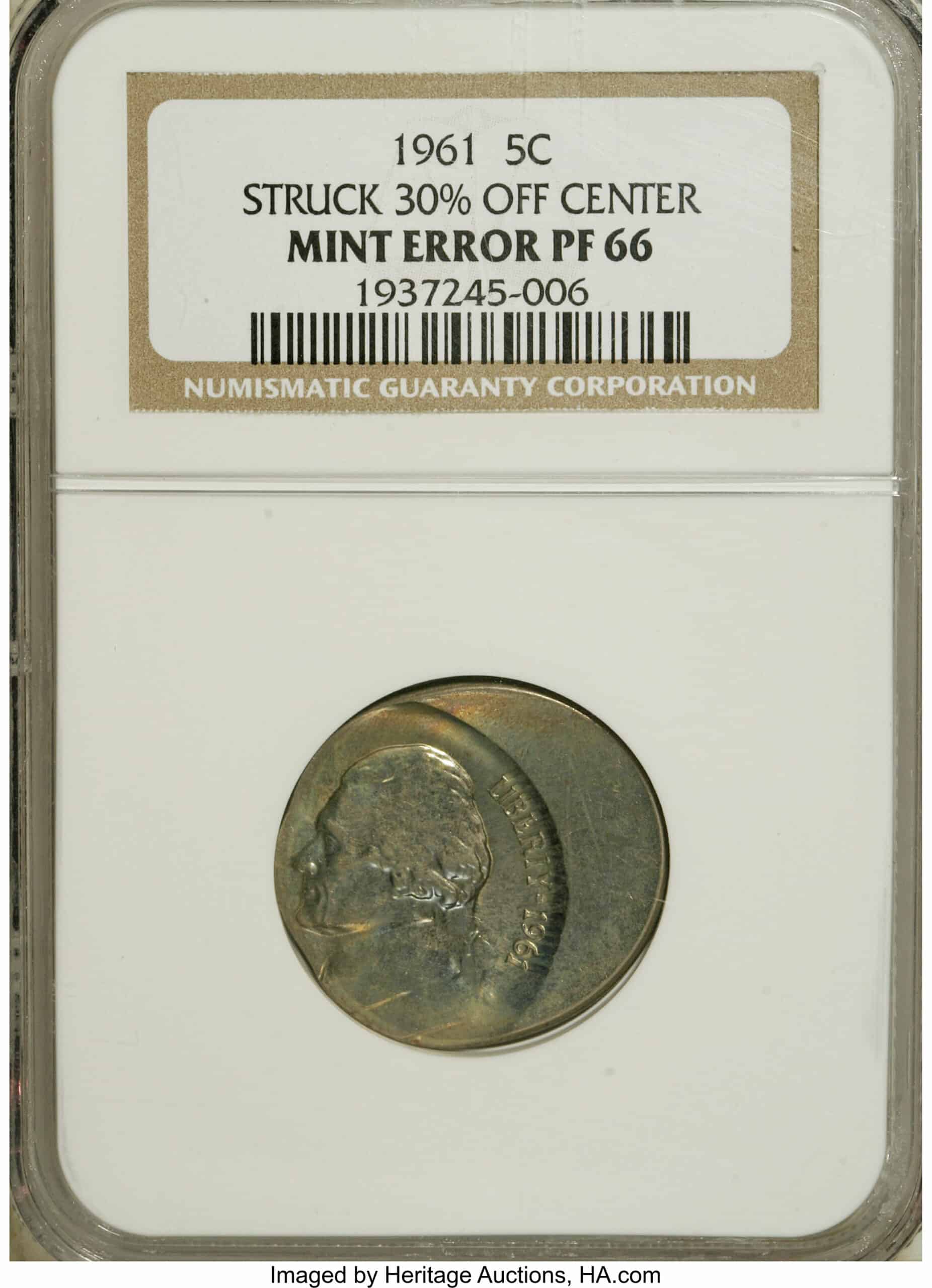
An off-center strike occurs when the coin is struck off-center, resulting in a design that is not properly centered on the coin. These errors can range from minor to severe and can affect either side of the coin. The value of an off-center strike error can vary depending on the degree of the error and the rarity of the 1961 nickel coin.
2. Die Cracks
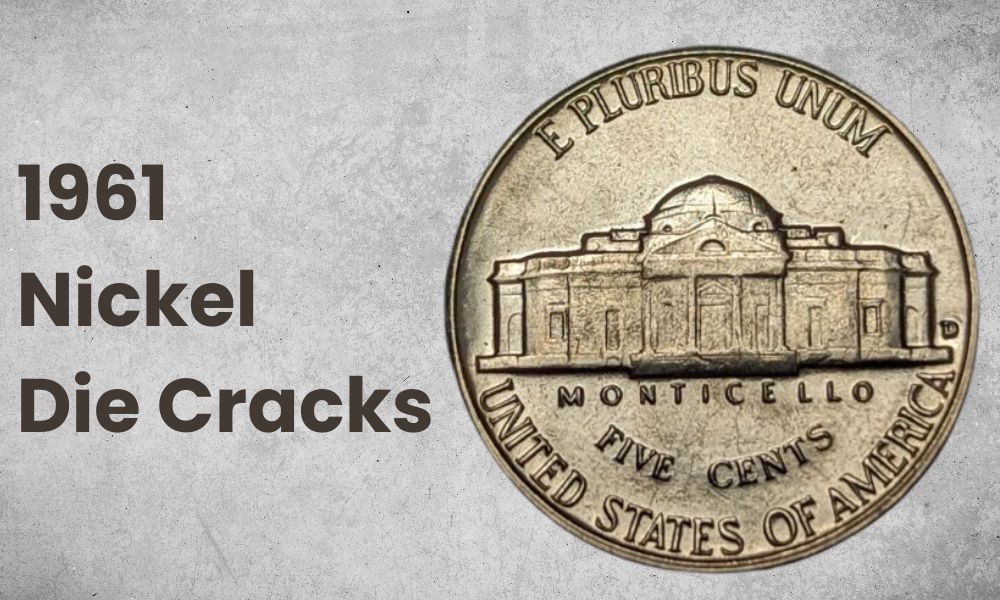
Die cracks occur when the die used to strike the coin begins to crack or chip. This typically results in a design that is distorted or incomplete. These errors also can range from minor to severe and can occur on either side of the coin. The value of a die crack error can vary depending on the degree of the error and the rarity of the 1961 nickel coin.
3. Planchet Errors
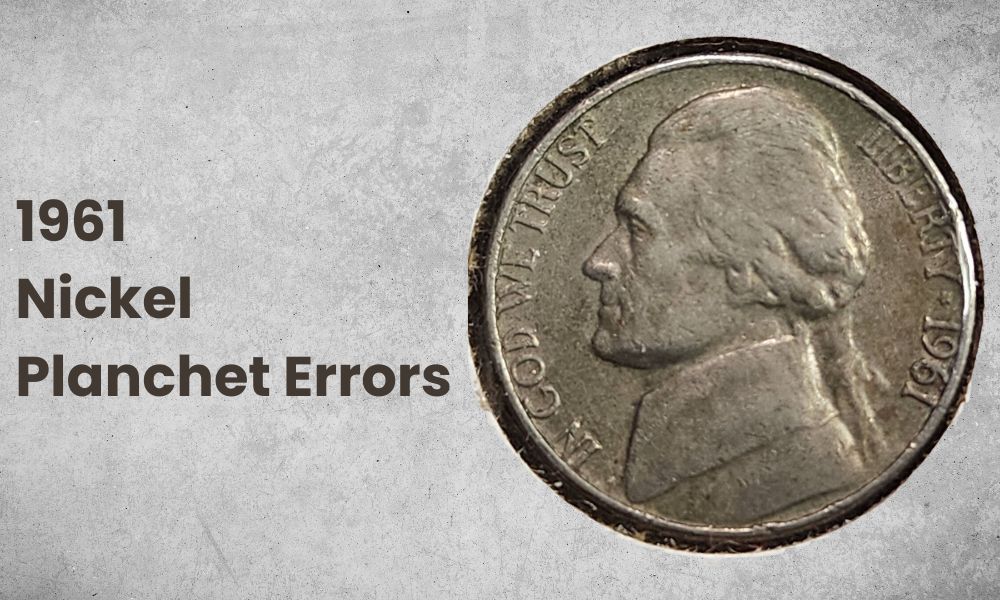
Planchet errors occur when the blank piece of metal used to strike the coin is flawed in some way. This can result in errors such as planchet cracks, laminations, and clips. Like with the off-center strike and die crack errors, the value of a planchet error can also vary depending on the degree of the error and the rarity of the coin.
4. Double Denomination
A double denomination error occurs when a coin is struck with two different denominations on either side of the coin. These errors are extremely rare and are often the result of mechanical errors during the minting process. The value of a double denomination error can vary greatly depending on the rarity and the condition of the 1961 nickel coin.
1961 Nickel FAQs
1. How much is a 1961 nickel worth?
The value of a 1961 nickel depends on a number of factors, including its condition, rarity, and any unique features or varieties. In general, circulated coins are worth between 5 and 50 cents, while uncirculated coins can be worth over $1,000 dollars.
2. What is the most valuable 1961 nickel variety?
The most valuable variety of the 1961 nickel is the proof version. It was produced as a special edition and features a frosted design on a mirrored background. Proof 1961 nickels can be worth hundreds of dollars or more. However, regular coins in perfect condition can be worth even more.
3. How can I tell if my 1961 nickel is a proof coin?
Proof 1961 nickels have a frosted design on a mirrored background. It gives them a distinct appearance. They were produced only at the Philadelphia mint, so don’t have a mint mark.
4. What is the difference between a circulated and uncirculated 1961 nickel?
Circulated 1961 nickel coins have been used in everyday transactions and may show signs of wear and tear, while uncirculated coins have not been used in circulation and retain much of their original luster. Uncirculated coins are typically more valuable to collectors, as they are in better condition than circulated coins.
5. Should I clean my 1961 nickel?
No, you should never clean your coins, as this can damage their surfaces and reduce their value. If you have a dirty or tarnished coin, it’s best to consult a professional coin dealer for advice.
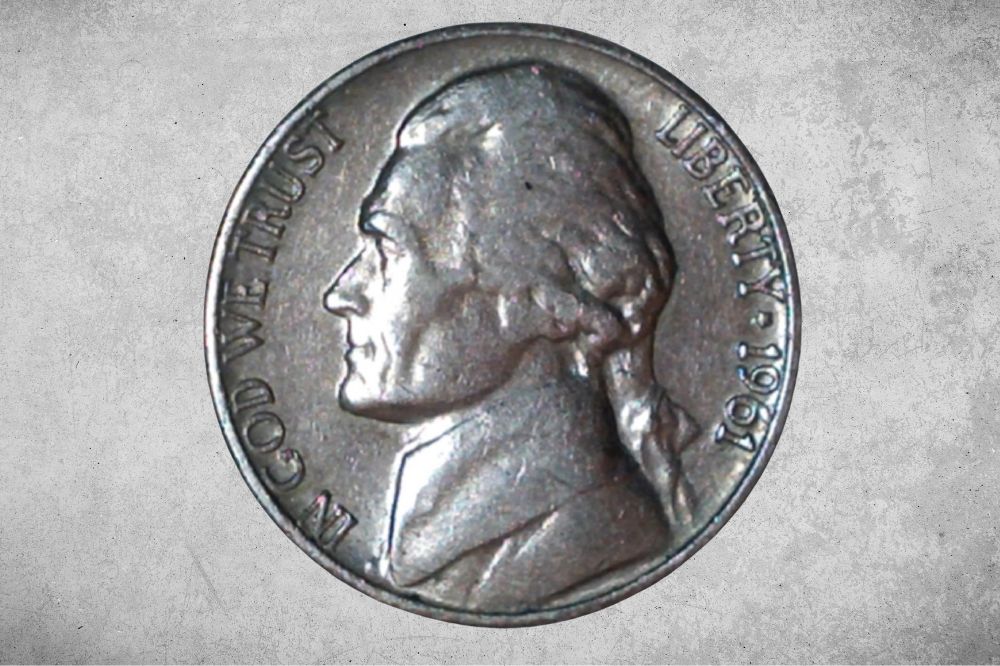
I have about 100 1961 JEFFERSON NICKELS with D MINT MAKE